Li Song
Spatial Computing Communications for Multi-User Virtual Reality in Distributed Mobile Edge Computing Network
Oct 16, 2025Abstract:Immersive virtual reality (VR) applications impose stringent requirements on latency, energy efficiency, and computational resources, particularly in multi-user interactive scenarios. To address these challenges, we introduce the concept of spatial computing communications (SCC), a framework designed to meet the latency and energy demands of multi-user VR over distributed mobile edge computing (MEC) networks. SCC jointly represents the physical space, defined by users and base stations, and the virtual space, representing shared immersive environments, using a probabilistic model of user dynamics and resource requirements. The resource deployment task is then formulated as a multi-objective combinatorial optimization (MOCO) problem that simultaneously minimizes system latency and energy consumption across distributed MEC resources. To solve this problem, we propose MO-CMPO, a multi-objective consistency model with policy optimization that integrates supervised learning and reinforcement learning (RL) fine-tuning guided by preference weights. Leveraging a sparse graph neural network (GNN), MO-CMPO efficiently generates Pareto-optimal solutions. Simulations with real-world New Radio base station datasets demonstrate that MO-CMPO achieves superior hypervolume performance and significantly lower inference latency than baseline methods. Furthermore, the analysis reveals practical deployment patterns: latency-oriented solutions favor local MEC execution to reduce transmission delay, while energy-oriented solutions minimize redundant placements to save energy.
AlignGS: Aligning Geometry and Semantics for Robust Indoor Reconstruction from Sparse Views
Oct 09, 2025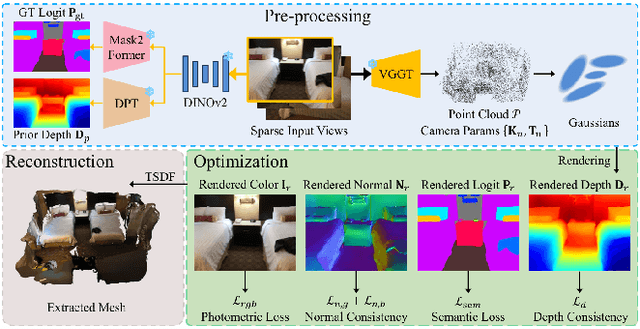
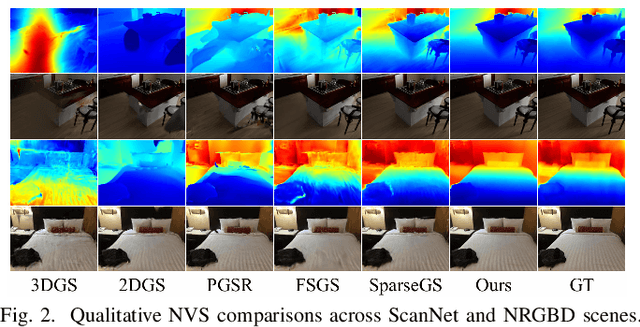
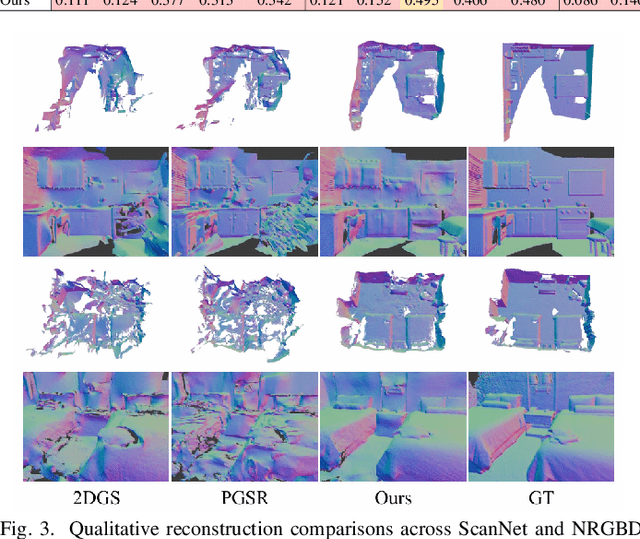

Abstract:The demand for semantically rich 3D models of indoor scenes is rapidly growing, driven by applications in augmented reality, virtual reality, and robotics. However, creating them from sparse views remains a challenge due to geometric ambiguity. Existing methods often treat semantics as a passive feature painted on an already-formed, and potentially flawed, geometry. We posit that for robust sparse-view reconstruction, semantic understanding instead be an active, guiding force. This paper introduces AlignGS, a novel framework that actualizes this vision by pioneering a synergistic, end-to-end optimization of geometry and semantics. Our method distills rich priors from 2D foundation models and uses them to directly regularize the 3D representation through a set of novel semantic-to-geometry guidance mechanisms, including depth consistency and multi-faceted normal regularization. Extensive evaluations on standard benchmarks demonstrate that our approach achieves state-of-the-art results in novel view synthesis and produces reconstructions with superior geometric accuracy. The results validate that leveraging semantic priors as a geometric regularizer leads to more coherent and complete 3D models from limited input views. Our code is avaliable at https://github.com/MediaX-SJTU/AlignGS .
PrismGS: Physically-Grounded Anti-Aliasing for High-Fidelity Large-Scale 3D Gaussian Splatting
Oct 09, 2025Abstract:3D Gaussian Splatting (3DGS) has recently enabled real-time photorealistic rendering in compact scenes, but scaling to large urban environments introduces severe aliasing artifacts and optimization instability, especially under high-resolution (e.g., 4K) rendering. These artifacts, manifesting as flickering textures and jagged edges, arise from the mismatch between Gaussian primitives and the multi-scale nature of urban geometry. While existing ``divide-and-conquer'' pipelines address scalability, they fail to resolve this fidelity gap. In this paper, we propose PrismGS, a physically-grounded regularization framework that improves the intrinsic rendering behavior of 3D Gaussians. PrismGS integrates two synergistic regularizers. The first is pyramidal multi-scale supervision, which enforces consistency by supervising the rendering against a pre-filtered image pyramid. This compels the model to learn an inherently anti-aliased representation that remains coherent across different viewing scales, directly mitigating flickering textures. This is complemented by an explicit size regularization that imposes a physically-grounded lower bound on the dimensions of the 3D Gaussians. This prevents the formation of degenerate, view-dependent primitives, leading to more stable and plausible geometric surfaces and reducing jagged edges. Our method is plug-and-play and compatible with existing pipelines. Extensive experiments on MatrixCity, Mill-19, and UrbanScene3D demonstrate that PrismGS achieves state-of-the-art performance, yielding significant PSNR gains around 1.5 dB against CityGaussian, while maintaining its superior quality and robustness under demanding 4K rendering.
OmniVTLA: Vision-Tactile-Language-Action Model with Semantic-Aligned Tactile Sensing
Aug 12, 2025Abstract:Recent vision-language-action (VLA) models build upon vision-language foundations, and have achieved promising results and exhibit the possibility of task generalization in robot manipulation. However, due to the heterogeneity of tactile sensors and the difficulty of acquiring tactile data, current VLA models significantly overlook the importance of tactile perception and fail in contact-rich tasks. To address this issue, this paper proposes OmniVTLA, a novel architecture involving tactile sensing. Specifically, our contributions are threefold. First, our OmniVTLA features a dual-path tactile encoder framework. This framework enhances tactile perception across diverse vision-based and force-based tactile sensors by using a pretrained vision transformer (ViT) and a semantically-aligned tactile ViT (SA-ViT). Second, we introduce ObjTac, a comprehensive force-based tactile dataset capturing textual, visual, and tactile information for 56 objects across 10 categories. With 135K tri-modal samples, ObjTac supplements existing visuo-tactile datasets. Third, leveraging this dataset, we train a semantically-aligned tactile encoder to learn a unified tactile representation, serving as a better initialization for OmniVTLA. Real-world experiments demonstrate substantial improvements over state-of-the-art VLA baselines, achieving 96.9% success rates with grippers, (21.9% higher over baseline) and 100% success rates with dexterous hands (6.2% higher over baseline) in pick-and-place tasks. Besides, OmniVTLA significantly reduces task completion time and generates smoother trajectories through tactile sensing compared to existing VLA.
PA-HOI: A Physics-Aware Human and Object Interaction Dataset
Aug 08, 2025



Abstract:The Human-Object Interaction (HOI) task explores the dynamic interactions between humans and objects in physical environments, providing essential biomechanical and cognitive-behavioral foundations for fields such as robotics, virtual reality, and human-computer interaction. However, existing HOI data sets focus on details of affordance, often neglecting the influence of physical properties of objects on human long-term motion. To bridge this gap, we introduce the PA-HOI Motion Capture dataset, which highlights the impact of objects' physical attributes on human motion dynamics, including human posture, moving velocity, and other motion characteristics. The dataset comprises 562 motion sequences of human-object interactions, with each sequence performed by subjects of different genders interacting with 35 3D objects that vary in size, shape, and weight. This dataset stands out by significantly extending the scope of existing ones for understanding how the physical attributes of different objects influence human posture, speed, motion scale, and interacting strategies. We further demonstrate the applicability of the PA-HOI dataset by integrating it with existing motion generation methods, validating its capacity to transfer realistic physical awareness.
AnimeColor: Reference-based Animation Colorization with Diffusion Transformers
Jul 27, 2025Abstract:Animation colorization plays a vital role in animation production, yet existing methods struggle to achieve color accuracy and temporal consistency. To address these challenges, we propose \textbf{AnimeColor}, a novel reference-based animation colorization framework leveraging Diffusion Transformers (DiT). Our approach integrates sketch sequences into a DiT-based video diffusion model, enabling sketch-controlled animation generation. We introduce two key components: a High-level Color Extractor (HCE) to capture semantic color information and a Low-level Color Guider (LCG) to extract fine-grained color details from reference images. These components work synergistically to guide the video diffusion process. Additionally, we employ a multi-stage training strategy to maximize the utilization of reference image color information. Extensive experiments demonstrate that AnimeColor outperforms existing methods in color accuracy, sketch alignment, temporal consistency, and visual quality. Our framework not only advances the state of the art in animation colorization but also provides a practical solution for industrial applications. The code will be made publicly available at \href{https://github.com/IamCreateAI/AnimeColor}{https://github.com/IamCreateAI/AnimeColor}.
DualComp: End-to-End Learning of a Unified Dual-Modality Lossless Compressor
May 22, 2025Abstract:Most learning-based lossless compressors are designed for a single modality, requiring separate models for multi-modal data and lacking flexibility. However, different modalities vary significantly in format and statistical properties, making it ineffective to use compressors that lack modality-specific adaptations. While multi-modal large language models (MLLMs) offer a potential solution for modality-unified compression, their excessive complexity hinders practical deployment. To address these challenges, we focus on the two most common modalities, image and text, and propose DualComp, the first unified and lightweight learning-based dual-modality lossless compressor. Built on a lightweight backbone, DualComp incorporates three key structural enhancements to handle modality heterogeneity: modality-unified tokenization, modality-switching contextual learning, and modality-routing mixture-of-experts. A reparameterization training strategy is also used to boost compression performance. DualComp integrates both modality-specific and shared parameters for efficient parameter utilization, enabling near real-time inference (200KB/s) on desktop CPUs. With much fewer parameters, DualComp achieves compression performance on par with the SOTA LLM-based methods for both text and image datasets. Its simplified single-modality variant surpasses the previous best image compressor on the Kodak dataset by about 9% using just 1.2% of the model size.
Distillation-Supervised Convolutional Low-Rank Adaptation for Efficient Image Super-Resolution
Apr 15, 2025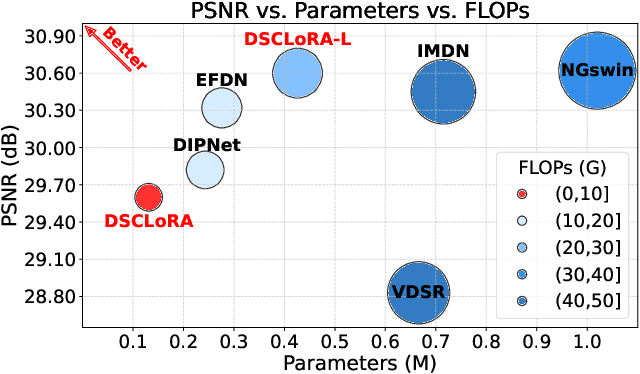
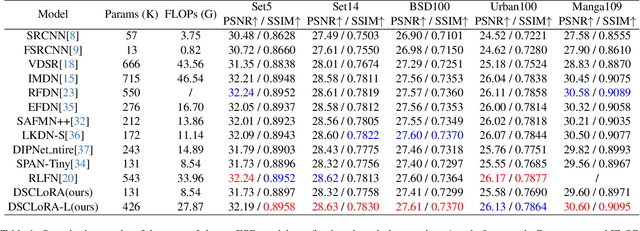
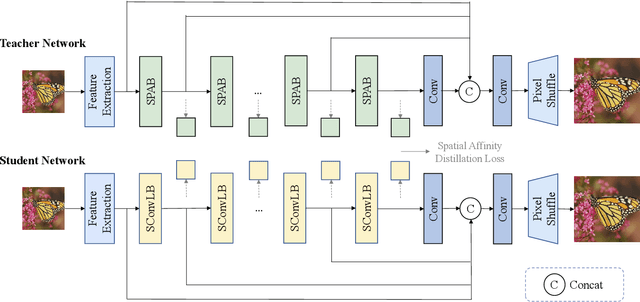
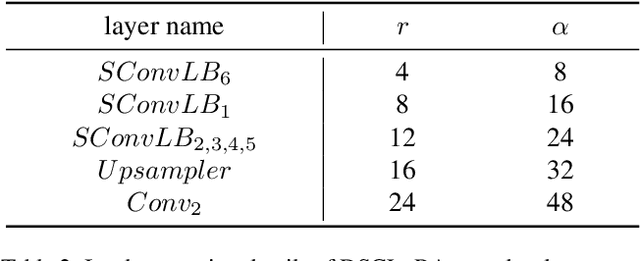
Abstract:Convolutional neural networks (CNNs) have been widely used in efficient image super-resolution. However, for CNN-based methods, performance gains often require deeper networks and larger feature maps, which increase complexity and inference costs. Inspired by LoRA's success in fine-tuning large language models, we explore its application to lightweight models and propose Distillation-Supervised Convolutional Low-Rank Adaptation (DSCLoRA), which improves model performance without increasing architectural complexity or inference costs. Specifically, we integrate ConvLoRA into the efficient SR network SPAN by replacing the SPAB module with the proposed SConvLB module and incorporating ConvLoRA layers into both the pixel shuffle block and its preceding convolutional layer. DSCLoRA leverages low-rank decomposition for parameter updates and employs a spatial feature affinity-based knowledge distillation strategy to transfer second-order statistical information from teacher models (pre-trained SPAN) to student models (ours). This method preserves the core knowledge of lightweight models and facilitates optimal solution discovery under certain conditions. Experiments on benchmark datasets show that DSCLoRA improves PSNR and SSIM over SPAN while maintaining its efficiency and competitive image quality. Notably, DSCLoRA ranked first in the Overall Performance Track of the NTIRE 2025 Efficient Super-Resolution Challenge. Our code and models are made publicly available at https://github.com/Yaozzz666/DSCF-SR.
LLM-Driven NPCs: Cross-Platform Dialogue System for Games and Social Platforms
Apr 14, 2025



Abstract:NPCs in traditional games are often limited by static dialogue trees and a single platform for interaction. To overcome these constraints, this study presents a prototype system that enables large language model (LLM)-powered NPCs to communicate with players both in the game en vironment (Unity) and on a social platform (Discord). Dialogue logs are stored in a cloud database (LeanCloud), allowing the system to synchronize memory between platforms and keep conversa tions coherent. Our initial experiments show that cross-platform interaction is technically feasible and suggest a solid foundation for future developments such as emotional modeling and persistent memory support.
The Tenth NTIRE 2025 Efficient Super-Resolution Challenge Report
Apr 14, 2025Abstract:This paper presents a comprehensive review of the NTIRE 2025 Challenge on Single-Image Efficient Super-Resolution (ESR). The challenge aimed to advance the development of deep models that optimize key computational metrics, i.e., runtime, parameters, and FLOPs, while achieving a PSNR of at least 26.90 dB on the $\operatorname{DIV2K\_LSDIR\_valid}$ dataset and 26.99 dB on the $\operatorname{DIV2K\_LSDIR\_test}$ dataset. A robust participation saw \textbf{244} registered entrants, with \textbf{43} teams submitting valid entries. This report meticulously analyzes these methods and results, emphasizing groundbreaking advancements in state-of-the-art single-image ESR techniques. The analysis highlights innovative approaches and establishes benchmarks for future research in the field.
 Add to Chrome
Add to Chrome Add to Firefox
Add to Firefox Add to Edge
Add to Edge